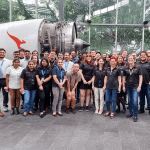Unlock the Future of Government IT with SIAM
Are you a CIO in the public sector looking to drive innovation and streamline your IT services? Discover how Service Integration and Management (SIAM) can transform your organisation’s IT landscape.
Download our comprehensive 5-Year Global Service Integration and Management Survey whitepaper now to gain invaluable insights and proven strategies from over 200 industry professionals.
In the fast-paced world of government IT, Chief Information Officers (CIOs) are always on the lookout for ways to drive innovation, optimise services, and achieve operational excellence.
Enter service integration and management (SIAM)—a strategy that’s proving to be a powerful advantage. SIAM helps public sector organisations streamline their processes and deliver better outcomes by coordinating multiple service providers effectively.
What is Service Integration and Management (SIAM)?
Service integration and management (SIAM) is all about orchestrating service provision across various service partners within an IT environment.
Leighton Freene, Kinetic IT’s Group Executive for Federal, Defence, and Emergency Services, explains it well:
“SIAM is the ability to coordinate service provision across many diverse service partners in an ICT environment. In the public sector, there are often multiple, large-scale contracts, or just multiple contracts being delivered side-by-side. The tendency is to consider ‘services’ being only those things that reside within a contract, instead of having an end-to-end view cross-functionally across an organisation.
“Often, you’ll have multiple service providers and service partners who are delivering different areas of a continuous service line. Having them all coordinated together means you get an optimised outcome, which is one of the biggest benefits of service integration and management.”

Why CIOs Should Consider SIAM
For CIOs, adopting a SIAM model offers several compelling benefits:
- Enhanced Measurement and Service Quality: With an end-to-end view of all service activities, organisations can better measure performance and ensure high standards of service quality.
- Improved Collaboration and Coordination: SIAM fosters enhanced cooperation among service providers, leading to more cohesive and efficient service delivery.
- Optimised Performance: Better coordination results in increased and optimised performance from service providers, ensuring optimal resource utilisation.
- Greater Control and Visibility: SIAM offers comprehensive oversight of the entire IT service landscape, enabling better decision-making and management.
Insights from the 2023 Global SIAM Survey
The 2023 Global Service Integration and Management (SIAM) Survey, sponsored by Kinetic IT, provides valuable insights into SIAM implementation and impact. Over 200 industry professionals and organisations participated, shedding light on the significant benefits and challenges of SIAM adoption. Key findings include:
- Enhanced Resilience and Responsiveness: Organisations implementing SIAM models report improved resilience and responsiveness to customer feedback.
- Improved Incident Response Times: Better coordination among service providers leads to faster incident response times.
- Continuous Service Improvement: SIAM facilitates ongoing service improvements and fosters innovation.
- Cost Reductions: Effective SIAM implementation often results in cost savings in service delivery.
Real-World Success Stories
Kinetic IT, a leading service integration provider in Australia, has successfully implemented SIAM models for major organisations such as the Australian Department of Defence and Qantas Group.
“Through service integration and management, your agency will be optimised from both a resource and user experience perspective,” Leighton explains.
“So the service itself becomes more resilient, reactive to customer feedback and engagement, and as a side effect generally you’ll see cost reductions in the services that are being provided.
“With better coordination, the speed at which you respond to incidents increases, the continual service improvement which you’re seeking across the service line increases, and optimisation from services and innovation increases. The more coordination and collaboration you can get across multiple service providers when they’re equally contributing into an ecosystem, the better outcome you get from a user experience perspective.”

Implementing SIAM: A Roadmap for CIOs
Transitioning to a SIAM model is a strategic process that typically spans 12 to 24 months, as shown in the Global SIAM Survey. This timeframe is the ‘sweet spot’ that allows for in-depth analysis on service provider performance to happen, as well as growing modern practices around iteration and innovation. This approach also has the ripple effect beyond the IT department, impacting the wider agency.
“I can’t think of a situation where service integration wouldn’t be required, regardless of the size and scale of an organisation,” Leighton says. “Because at its heart is coordination across your assets, services, delivering through to your end users.
So, I think it’s always going to be necessary. My advice to CIOs would be to look at your services and view them end-to-end as a service line, rather than the bits and pieces that you stick in individual service provider contracts.”
Steps for Effective SIAM Implementation
- Adopt an End-to-End Service View: Move away from fragmented contract-based approaches and adopt a holistic, end-to-end view of your services.
- Choose the Right Partner: Partnering with a service integration provider with specific onshore capabilities is crucial. Kinetic IT, for example, offers agile and collaborative coordination across multiple vendors.
- Recognise Staged Improvements: Understanding that improvements are staged helps manage expectations and ensures a smoother transition.
SIAM as a Strategic Advantage for CIOs
Service integration and management is not just a trend but a strategic imperative for CIOs in the public sector. It enables government agencies to achieve better service coordination, optimised performance, and greater overall control. As Leighton aptly puts it:
“At its heart, SIAM is about coordination across your assets, services, delivering through to your end users.”
Connect with Leighton on LinkedIn.
For CIOs looking to drive innovation and optimise IT service delivery, SIAM offers a robust framework for achieving excellence. Explore the 5-Year Global Service Integration and Management Survey for more in-depth insights and learn how Kinetic IT can tailor SIAM solutions to meet your organisation’s unique needs.















